In Gaza: Bombing and Overcrowding, Two Faces of One Death

Between dangerous areas and others labeled “safe” but overcrowded, Gaza’s residents find themselves forced to stay under bombardment, even at the cost of their lives.
-
Hostage Operations: How Does Israel Gather Intelligence in Gaza?
-
Despair Increases in the “Death Zone”: UN Alarm Over “Appalling Conditions” in Gaza
The overcrowding in the area Israel designates as “safe” deters those who have been ordered to evacuate by the Israeli army from leaving.
The newspaper states that thousands of people facing Israeli airstrikes in Gaza have had to abandon their plans to comply with Israeli evacuation orders directing them to a designated “safe humanitarian zone” because there is no room for them there.
-
Israel Announces End of Military Operations in Gaza
-
Gaza Negotiations and Hostage Families: Mounting Pressure Awaiting the ‘Last Chance’
Over the weekend, the Israeli army informed residents of several neighborhoods in the city of Deir al-Balah and its surroundings in central Gaza to leave their homes ahead of planned attacks.
They were instructed to go to the narrow strip of coastline around the small Mawassi area, west of Khan Younis, which was earlier designated during the war to receive displaced people.
-
From Underground… How Does Yahya Sinwar Communicate with Hamas Leaders Inside and Outside Gaza?
-
Between Sinwar’s Approval and Israel’s Rejection… An Uncertain Fate Awaits Gaza Truce Negotiations
No Space
A 34-year-old displaced woman living with 16 relatives near the designated “safe” zone states: “My uncles and father tried to find a safer place for our family to move to, but their efforts failed as all spaces inside the safe zone were occupied.”
She adds: “My family fled from Rafah to another so-called safe zone. Now we know there is no such thing.”
-
Analysts reveal the suffering of citizens in Gaza due to the ongoing conflict
-
Gaza War Casts a Shadow over ‘Nagasaki Anniversary’… Politics Overshadow Humanity
Meanwhile, humanitarian officials confirmed that the overcrowding in the “humanitarian” zone discourages those ordered to evacuate by Israeli forces from leaving, despite the dangers of staying.
A United Nations official based in Gaza said: “There isn’t enough space, and people know that, so they stay where they are. You can’t get tents, so even if you find a spot, it will be difficult to find any shelter. The conditions are dreadful.”
-
Illusory Optimism or New Pressures: What Lies Behind American Claims About Ceasefire Negotiations in Gaza?
-
Three Arab States Refuse to Participate in Gaza Peacekeeping Force
He added: “Some people refuse to go to Mawassi simply because they don’t want to leave their homes, but most refuse because they will have nowhere to live if they go there.”
Since the outbreak of the Israeli war on October 7, the vast majority of Gaza’s residents have been displaced, often multiple times. According to the UN, 86% of the land has been placed under evacuation orders by the Israeli army.
-
Death Toll Rises in Gaza and Tunnel Discovered Under Philadelphi Corridor
-
Spokeswoman for the Palestinian Red Crescent: The Israeli Occupation Targets Hospitals in Gaza
The Mawassi area has been overcrowded with hundreds of thousands of displaced people since the conflict began, despite the lack of basic services there.
Water supplies are insufficient, sanitation is almost non-existent, healthcare is rudimentary, and infectious diseases are on the rise. Aid organizations fear outbreaks of diseases like polio.
-
CNN: New Israeli Evacuation Orders for Thousands of Palestinians in Gaza
-
9 months after the Gaza War… “Day of Paralysis” in Israel and protests sweep the country
In a UN report issued last Monday, it was stated that since the beginning of this month, the Israeli army has issued nine evacuation orders, affecting an estimated 213,000 people across Gaza.
The report stated that Gaza’s population, which was 2.3 million before the war, is “increasingly concentrated” within the area designated by Israel in Mawassi, where each square kilometer now holds between 30,000 and 34,000 people, compared to around 1,200 before October 2023.
-
Leads to Agreement Ending Gaza War… Hamas “Abandons” Condition Hindering Negotiations
-
“Loophole” in Gaza ceasefire negotiations… Hamas condition clashes with Israeli wall
Since last month’s Israeli military order, the area of the humanitarian zone has shrunk by a fifth to 40 square kilometers — just 11% of Gaza’s land.
The UN states that “this reduction in space, combined with overcrowding, increasing insecurity, inadequate and overburdened infrastructure, continuing hostilities, and limited services, is exacerbating the already dire humanitarian situation for the hundreds of thousands of people forced to live in this zone.”
-
Gaza Ceasefire Negotiations: Progress Toward a Crucial Breakthrough, Hopes for Imminent Resolution
-
Palestinian Analyst highlights harsh humanitarian conditions in Gaza
The Israeli army justifies this reduction by stating that “the eastern part of the zone is being used to launch rockets into Israel.”
On Monday, the Israeli army recovered the bodies of six hostages who had been held in Gaza since the start of the conflict in a tunnel beneath a previously designated part of the humanitarian zone.
-
Israel Sets Date to End “Gaza Incursion” and Outlines Next Phase
-
U.S. Weapons for Israel Since the Gaza War: By the Numbers
Staying Despite the Bombing
In another instance, a series of airstrikes on the “humanitarian” zone has convinced many Gazans who have been ordered to evacuate that they are better off staying where they are.
Last July, Israel carried out a deadly strike on Mawassi, claiming it was targeting Mohammed Deif, the head of the al-Qassam brigades, the military wing of Hamas.
However, the strike killed at least 92 people and injured over 300 others, according to figures from Gaza’s Ministry of Health.
-
Gaza Under Fire, Famine, and the Unknown… A Disaster Arising from the Ashes
-
UNRWA: “Looting” Operations Hamper Aid Delivery in Gaza
Youssef Abu Taima, from the town of Qarara in Khan Younis, is preparing to move his family for the fourth time after an Israeli order: “There is no safe place.”
In some cases, people are unable to make it to Mawassi or elsewhere because they don’t have any fuel.
That was the case for Siham Bahjat, 24, who said that her family of eight attempted to flee their tents on the outskirts of the humanitarian zone on Monday afternoon after hearing nearby gunfire.
-
Exploiting Palestinian Suffering… How the Muslim Brotherhood Capitalized on the Gaza War
-
“Famine” Reemerges in Northern Gaza, Looming Shadow in the Center and South
She explains: “We packed all our important belongings, but we couldn’t go far because we ran out of gas, which has been extremely hard to get for months. So we decided to stay and sleep where we were.”
To date, the war has killed more than forty thousand Palestinians in the Gaza Strip and destroyed thousands of residential units, including entire neighborhoods.












